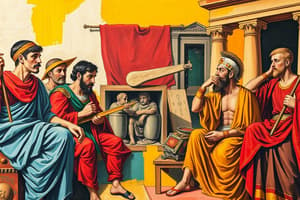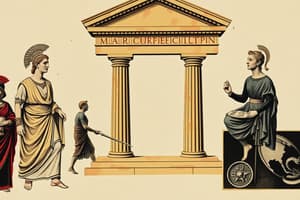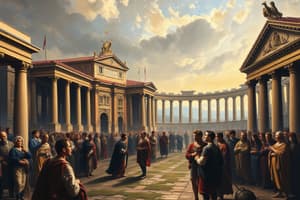Podcast
Questions and Answers
What were Patricians in Ancient Rome?
What were Patricians in Ancient Rome?
Who were Plebeians?
Who were Plebeians?
What is a Republic?
What is a Republic?
A form of government with an elected leader
What was the Senate in Ancient Rome?
What was the Senate in Ancient Rome?
Signup and view all the answers
What is the role of a Consul?
What is the role of a Consul?
Signup and view all the answers
What is a Tribune?
What is a Tribune?
Signup and view all the answers
What does Veto mean in the context of Roman government?
What does Veto mean in the context of Roman government?
Signup and view all the answers
Study Notes
Social Classes in Ancient Rome
- Patricians were the wealthy elite of Rome, comprising a small, privileged group of landowners.
- They held political power and were referred to as "the fathers of state," serving as advisors to the Etruscan kings.
- Plebeians represented the lower class, including peasants, laborers, craftsmen, and shopkeepers, and had limited political influence.
Political Structure
- The Roman Republic was established as a form of governance with elected officials to represent the citizens.
- The Senate consisted of 300 prominent members who were responsible for governing Rome’s political affairs in the Republic.
- Consuls served as the chief executives in the Republic, with a dual leadership structure ensuring balanced governance.
Representation and Rights
- Tribunes were elected representatives chosen by the plebeians, tasked with the protection of their rights and interests within the government.
- The concept of veto allowed officials to reject Senate proposals, serving as a check on legislative power to safeguard the interests of the lower classes.
Studying That Suits You
Use AI to generate personalized quizzes and flashcards to suit your learning preferences.
Description
Explore the social structure of Ancient Rome with our flashcards on Patricians and Plebeians. Understand the distinct roles and influences of these classes in Roman society and the foundations of the Republic. Perfect for students looking to grasp the complexities of Roman governance.




